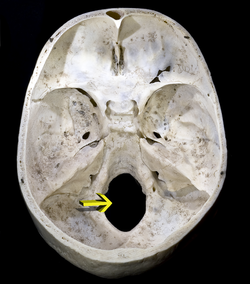Foramen Magnum
The Foramen Magnum (Latin: great hole) is a large oval opening (foramen) in the occipital bone of the skull in humans and various other animals. It is one of the several oval or circular openings (foramina) in the base of the skull. The spinal cord, an extension of the medulla, passes through the foramen magnum as it exits the cranial cavity.
Apart from the transmission of the Medulla Oblongata and its membranes, the foramen magnum transmits the vertebral arteries, the anterior and posterior spinal arteries, the tectorial membranes and alar ligaments. It also transmits the spinal component of the accessory nerve into the skull.[1]
C1 Atlas Vertebrae
Every organ associated with the meridians, namely Lung, Large Intestine, Stomach, Spleen, Heart, Small Intestine, Kidney, Pericardium, Triple Heater (endocrine system), Gallbladder and Liver, all have a direct or indirect neurological connection from the C1 (atlas) vertebrae with the exception of the Bladder. However one of the most significant points on the human body, BL10 is located directly over the atlas vertebrae and is where the Bladder meridian splits to form two distinct channels paravertebral down the spine to include the famous shu (associated) points. Therefore, all organ systems associated with the meridians are intimately related to the atlas vertebrae to include the Bladder due to this neurological connection.
Given the fact the Foramen Magnum (the opening at the base of the skull allowing the spinal cord to flow from the brain) can become partially occluded due to subluxation of the atlas vertebrae, which protects this area, it becomes obvious that this area is paramount for nerve flow through the body. Any disruption can cause extreme symptomatology and condition response. This is true for any neurological, visceral or musculoskeletal condition. [2]
